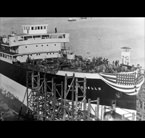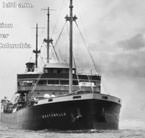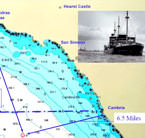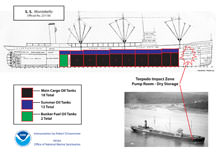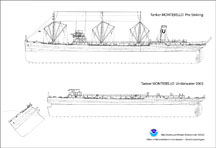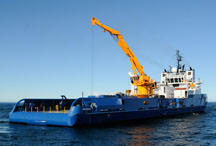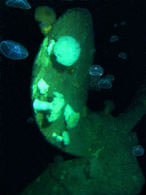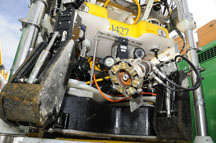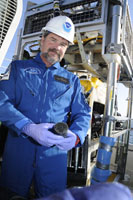Maritime Heritage: Field Research
Montebello
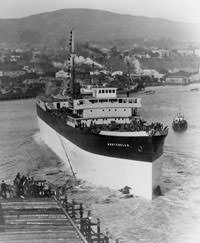 |
|---|
| Oil Tanker Montebello being launched on 24 January 1921 at Southwestern Shipbuilding Company in East San Pedro, CA. (Credit: Unocal) |
Just south of the Monterey Bay National Marine Sanctuary boundary are the remains of the oil tanker Montebello. Built in 1921 at the Southwestern Shipbuilding Company in San Pedro California, the shelter deck tanker had an overall length of 457 feet (139 meters). The tanker, carrying over 3 million gallons of Santa Maria crude oil, was sunk by a single torpedo fired by a Japanese submarine during World War II on December 23, 1941; just two weeks after the attack on Pearl Harbor. It is believed the 18 cargo tanks containing the crude oil were not damaged during the attack.
The Montebello sits 900 feet below the surface of the Pacific Ocean, approximately seven miles off the coast of California near the town of Cambria, in San Luis Obispo County. The shipwreck Montebello has been visited several times by archaeologists, historians, and biologists to inspect the vessel and surrounding area for oil and wildlife.
In September of 2003, staff members from the Monterey Bay and Channel Islands National Marine Sanctuaries, and local agencies visited the oil tanker Montebello to conduct reconnaissance dives to monitor and characterize the condition of the vessel, and characterize the fish and invertebrate assemblages. No evidence of oil was found.
In early 2009, California Assemblyman Sam Blakeslee initiated a partnership with the Department of Fish and Game's Office of Spill Prevention and Response (OSPR). Blakeslee requested OSPR to coordinate a risk assessment to determine the likelihood of an oil release and the potential adverse effects this would cause on the Central Coast. Soon after, a multi-agency workgroup, the Montebello Assessment Task Force was formed to assess potential impacts to the marine environment and the California coast from the sunken oil tanker Montebello.
In September 2011, the U.S. Coast Guard awarded a contract to Global Diving and Salvage, Inc. to determine if oil was present aboard the sunken ship S.S. Montebello. The survey was conducted in October 2011, at which time a Unified Command led by the U.S. Coast Guard and California Department of Fish and Game's Office of Spill Prevention and Response assessed cargo and fuel tanks of the sunken ship S.S. Montebello. The Unifed Command determined that there is no substantial oil threat from the Montebello to California waters and shorelines. To view the Final Press Release of the 2011 Montebello Assessment, click here (78K PDF). A final report is expected in spring 2012.
The Montebello represents three different aspects of American history: the development and use of a petroleum tanker in times of peace and war; the dependence on maritime commerce to provide fuel for the industrial revolution; and growing United States military presence around the globe during World War II.
In September 2016, the Montebello shipwreck and remains were added to the National Register of Historic Places. The National Register listing provides additional federal protection for the wreck site and the artifacts there. The National Register of Historic Places is the Nation's official list of cultural places considered worth preserving. Authorized by the National Historic Preservation Act of 1966, the National Register is part of a national program to coordinate and support public and private efforts to identify, evaluate, and protect America's historic and archeological resources. Properties listed in the National Register can qualify for Federal grants for historic preservation.
The Montebello lies in the area proposed to NOAA to become a new national marine sanctuary - Chumash Heritage National Marine Sanctuary. NOAA has accepted the site into its inventory of areas that could one day be designated as a new national marine sanctuary.
S.S. Montebello Videos |
||||||||||
|
|
|
||||||||
S.S. Montebello Images |
|||||
|
|||||
|
|||||
|
|||||
|
|||||
|
|||||
|
|||||
|
|||||
|
|||||
|
|||||
Related Links
Visit the following web sites for more information on the Montebello:
Expeditions to the Shipwreck Montebello (Ecosystem Observations 2005, p.25):
https://montereybay.noaa.gov/reports/2005/eco/welcome.html
Summary of the 2010 seafloor mapping survey:
http://www.mbari.org/sonar-images-from-robotic-submersible-help-officials-determine-if-historic-shipwreck-poses-oil-pollution-threat/
California's Office of Spill Prevention and Response (OSPR) website on Montebello and Assessment Task Force:
https://www.wildlife.ca.gov/OSPR/News/Montebello
NPR: All Things Considered
Six Miles Off Shore: The Wreck of the Montebello (10/18/11)
http://www.npr.org/2011/10/18/141453907/oiafter-the-wreck-of-montebello
Final Press Release of the 2011 Montebello Assessment, concluding "No visual evidence of oil found onboard S.S. Montebello" (10/20/11):
http://montereybay.noaa.gov/new/archive2011.html
NOAA Researchers Investigate Shipwrecks and 'Mystery Oil Spills'
Part 1: A new field of study and the 'Montebello Mystery' (12/8/11)
http://oceanservice.noaa.gov/news/features/dec11/mysteryoil_pt1.html
NOAA Researchers Investigate Shipwrecks and 'Mystery Oil Spills'
Part 2: Long-sunk secrets rise slowly to the surface (12/12/11)
http://oceanservice.noaa.gov/news/features/dec11/mysteryoil_pt2.html

